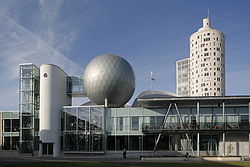Tartu
Tartu is the second biggest city in Estonia. The University of Tartu, the oldest and most famous in Estonia is found there. Around 102,000 people were living in Tartu as of 2008.
City | |
| Tartu linn City of Tartu | |
|
| |
| Coordinates: 58°23′N 26°43′E / 58.383°N 26.717°ECoordinates: 58°23′N 26°43′E / 58.383°N 26.717°E | |
| Country | |
| County | |
| First settled | 5th century AD |
| First mentioned | 1030 |
| City rights | before 1262 |
| Named for | Taara or tarvas (Aurochs) |
| Government | |
| • Mayor | Urmas Klaas (Reform Party) |
| Area | |
| • Total | 38.80 km2 (15 sq mi) |
| • Land | 37.9 km2 (14.6 sq mi) |
| • Water | 1.3 km2 (0.5 sq mi) 3.39% |
| Elevation | 57.2 m (188 ft) |
| Highest elevation | 79 m (259 ft) |
| Population (2017)[1] | |
| • Total | 96,904 |
| • Rank | 2nd |
| • Density | 2,508.6/km2 (6,497/sq mi) |
| Ethnicity | |
| • Estonians | 80.1% |
| • Russians | 14.6% |
| • other | 5.3% |
| Time zone | UTC+2 (EET) |
| • Summer (DST) | UTC+3 (EEST) |
| Postal code | 50050 to 51111 |
| Vehicle registration | T |
| Website | tartu.ee |
Twin towns
These are the twin towns of Tartu:
|
|
Gallery
Tartu Media
Aerial view of Toomemägi, Tartu cathedral and Tartu downtown
References
- ↑ "Eesti elanike arv KOV" (PDF). Interior Ministry. Archived from the original (PDF) on 2017-10-14. Retrieved 2017-01-01.
| Wikimedia Commons has media related to Lua error in Module:Commons_link at line 62: attempt to index field 'wikibase' (a nil value).. |
















